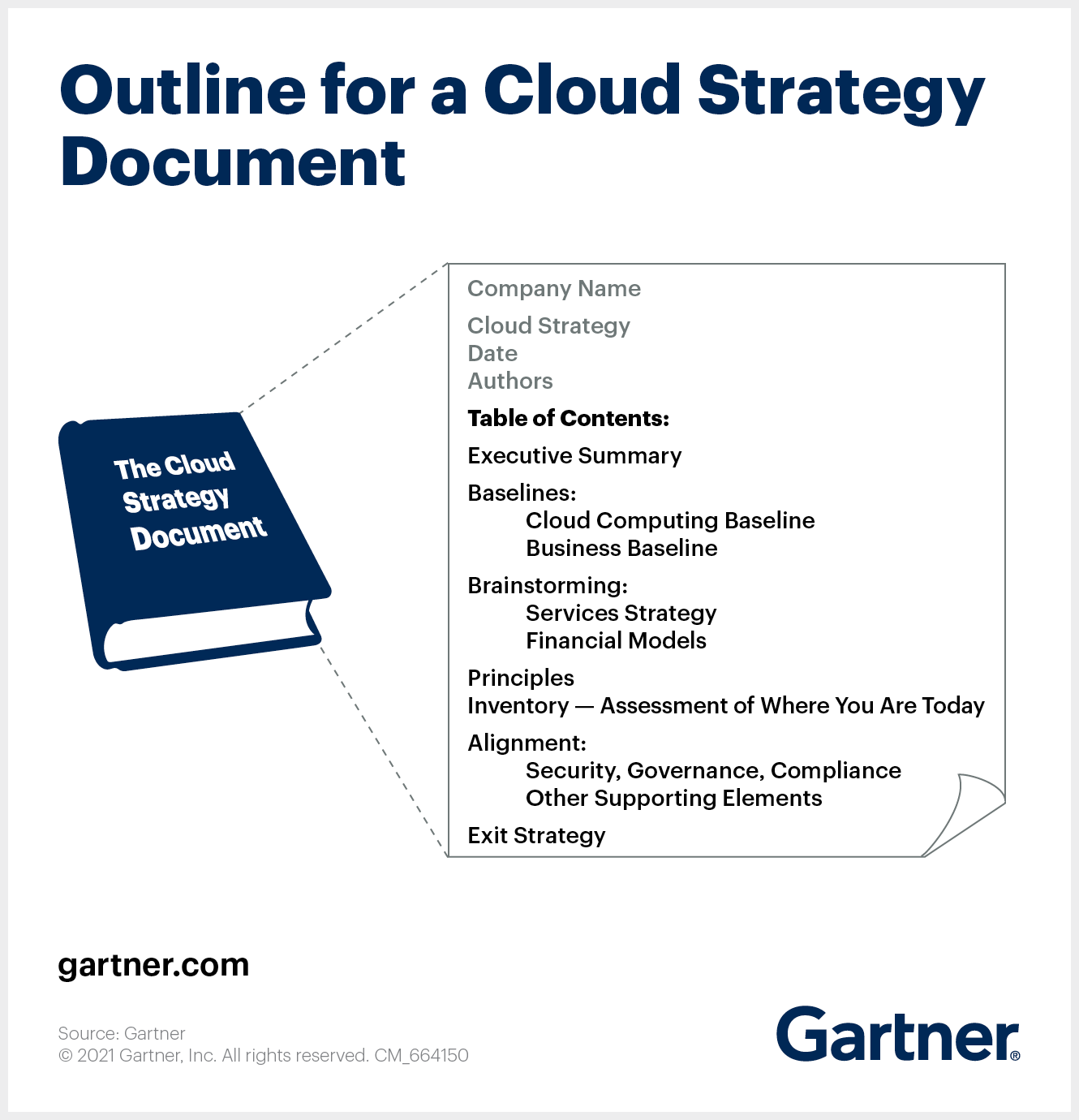Build your cloud strategy by planning and assembling ingredients as you would for a fine meal.
- Gartner client? Log in for personalized search results.
The Cloud Strategy Cookbook
April 6, 2021
Contributor: Katie Costello
Theoretically, business leaders know it is important to have strategies in place to align stakeholders, decision making and activities with future organisational goals, but many still struggle when it comes to actually crafting those strategies. However, organisations with developed strategies are in a better position to obtain business value—especially when it comes to cloud computing.
A cloud strategy is a concise viewpoint on the role of cloud computing in your organisation. It is different from a cloud implementation plan, which offers the “how” rather than the “what” and “why” questions of a cloud strategy. It is not an attempt to solve everything nor a plan to move everything to the cloud.
Many of the top questions in cloud computing actually revolve around cloud strategy, and they are becoming more urgent: “What is a cloud strategy and why do I need one?” or “How do we build a comprehensive cloud strategy?”
The sooner you establish a cloud strategy, the more able you will be able to anticipate the benefits and downsides of cloud use in your organisation. Plus, it is never too late to develop one. Here are the 10 ingredients to include in your organisation’s cloud strategy cookbook.

Executive Summary
This is your chance to communicate with senior management on the high-level direction of cloud implementations at your organisation. Summarise the contents of the strategy document in a way that demonstrates value to people outside of IT. Include details such as the names and roles of those in your organisation’s cloud council, or the cross-functional stakeholders who validate the strategy and drive support where needed. Though it will be the first thing people see, write the executive summary last, as it summarises the entire effort.
Cloud Computing Baseline
This is where you will identify all terms and associated definitions that appear within the cloud strategy.
Many newer terms in cloud computing (for example, multicloud, cloud-native or distributed cloud) are often cited as core parts of a cloud strategy, but the meanings aren’t well established. Use existing terms; do not reinvent them. In this section, you can also refer to an appendix that gives more detail.
What is important is that all stakeholders agree on the definitions. The key is to eliminate confusion and use terms consistently when engaging in cloud computing conversations.
Business Baseline
This section should map the business goals to the potential benefits of cloud computing and explain how to overcome the potential challenges. It should state why the organisation is interested in the cloud initially.
Explore what the business is trying to accomplish, whether you need to align with an existing data centre strategy, whether extenuating circumstances exist, and, of course, the impact of responding to uncertainties like the COVID-19 pandemic.
Read More:Gartner Top 6 Trends Impacting Infrastructure & Operations in 2021
Services Strategy
A discussion on services strategy is a good starting point for a brainstorming session to determine your guiding principles. Determine when to use cloud services from a public cloud provider versus build or maintain capabilities on-premises or elsewhere.
Distinguish between use cases for infrastructure-as-a-service (IaaS), platform-as-a-service (PaaS) and software-as-a-service (SaaS). Examine the applicability of all potential roles in cloud computing—consumer, provider and broker—and remember, it is typically a huge effort to build cloud services.
Financial Considerations
As with most technology investments, there are financial considerations to cloud computing. It is imperative to understand pricing model trends to meet expectations.
For example, IaaS is mostly aligned with hardware costs, so the price tends to go down slowly over time. IaaS is mainly a pay-as-you-go model and contracts are not required. Compare this with SaaS for applications, where the prevalent model is subscription-based and the price tends to go up over time.
Above all else, do not believe the biggest myth about cloud—that you always save money by moving to it.
Principles
Principles are the most important part of an organisation’s cloud strategy and should be explicitly stated. Common ones include:
- Cloud first, or the suggestion that organisations consider the cloud as the first option for any new technology or business initiative. Gartner recommends cloud first in most cases. There are variations, such as cloud smart.
- Buy before build, which in the cloud is often stated as SaaS first, and more generally leads to packaged rather than bespoke solutions.
- Best-of-breed, meaning that the best solution is preferred over one that is more integrated and from the same vendor.
- Multicloud: This entails the use of multiple public cloud providers for business outcomes.
Be sure to also document any vendor-oriented considerations in this section, such as positive relationships or investment in skills.
Inventory Information
Workloads need to be inventoried to determine your current position. Basic information like name, ownership, dependencies and security requirements for each workload must be captured.
Because there will likely be hundreds, if not thousands, of workloads to examine within the organisation, additional focus should be on the most critical workloads and those that are costing the most. Understand them thoroughly before you make big decisions about changes.
Security
Cloud computing does not exist in a vacuum, and neither should your cloud strategy. It needs to align with existing strategies, such as those for security, which requires its own section.
“Security is a shared responsibility, but identifying roles and responsibilities in detail is critical to using the cloud securely,” says David Smith, Distinguished VP Analyst, Gartner. “For instance, it is not the provider’s fault if you leave your data unprotected. You must ensure that the data you put in IaaS is locked down appropriately.”
Adhere to your existing security strategy or change it to accommodate the realities of cloud computing.
Read More:Top Actions From Gartner Hype Cycle for Cloud Security, 2020
Supporting Elements
Often, other strategic efforts must be aligned with (including staffing, data centre, architecture and security). Staffing requirements are an important consideration in your cloud strategy. Cloud computing alters staffing requirements, depending on what level of cloud service you adopt: You will need a mix of skill sets to handle both administrative and higher-level tasks. Include HR as part of your cloud strategy council to ensure that staffing is properly addressed.
Exit Strategy
Although massive movement of workloads back from a public cloud is rare, it is vital to have an exit strategy that describes the dependencies and choices you have, just in case. In fact, several regulators, mainly in the EU and those in financial services, now mandate an exit strategy.
The “how” behind getting out of a cloud contract is important, but it is just the beginning. Examine other issues, including:
- Data ownership
- Backup
- Getting back your data
- Portability
Exit strategy and exit planning are often confused (as with the broader overall cloud strategy). Focus your exit strategy on answering “what” and “why” questions. Cover the answers to “how” questions in a more detailed exit plan that is workload-specific.
Bon Appétit!


